
Winter weeds
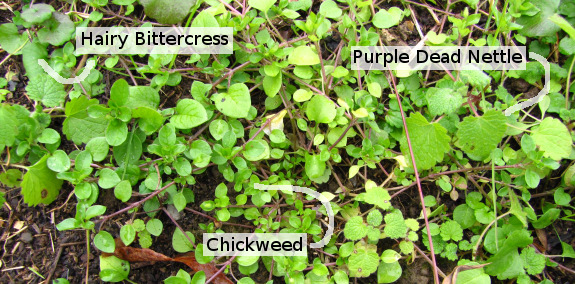
"Why mulch the garden
now?" Daddy asked when he was visiting in October. "Weeds aren't
going to grow this late in the season." It turns out that weeds were growing, and if I'd had my
act together, it would have been smarter to get the garden mulched down
by the end of September when a lot of the winter weeds
germinated. Your garden may have different trouble plants, but
these are our three most common winter weeds.
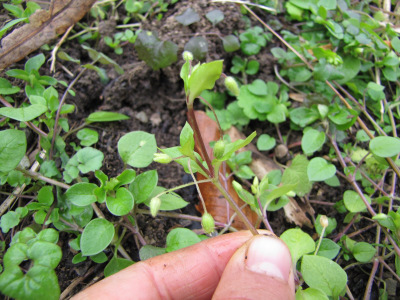 Common
Chickweed (Stellaria
media) loves
bare, disturbed ground and will quickly spread its runner-like stems
across your garden. Identify this alien species by the rosette
form of its growth, by the small, roundish leaves, and the tiny white
flowers. Although chickweed is a pain in the butt to hack out of
half-frozen ground when you want to plant your early spring crops, if
you do let the chickweed get ahead of you at least you'll know that the
chickweed greens are beloved by your flock of chickens. In fact, I've read
that common chickweed is often eaten by humans either in salad or as a
cooked green.
Common
Chickweed (Stellaria
media) loves
bare, disturbed ground and will quickly spread its runner-like stems
across your garden. Identify this alien species by the rosette
form of its growth, by the small, roundish leaves, and the tiny white
flowers. Although chickweed is a pain in the butt to hack out of
half-frozen ground when you want to plant your early spring crops, if
you do let the chickweed get ahead of you at least you'll know that the
chickweed greens are beloved by your flock of chickens. In fact, I've read
that common chickweed is often eaten by humans either in salad or as a
cooked green.
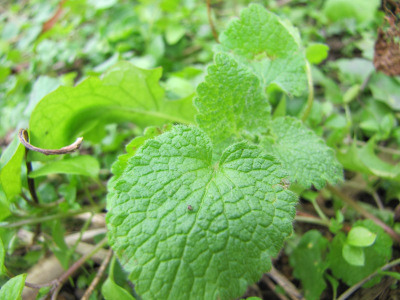 Purple Dead Nettle (Lamium
purpureum) is
easy to identify when it blooms in the early spring --- the top few
leaves turn purplish to set off the pink flowers, and the square stem
proclaims it to be a member of the mint family. At this time of
year, the non-stinging dead nettle takes a bit more care to identify,
but once you feel the fuzzy leaves, you'll realize few other wild
plants have the same gestalt. Like nearly all of our garden
weeds, Purple Dead Nettle hails from Europe, probably introduced for
the edible young leaves that can be eaten like chickweed.
Although Purple Dead Nettle does like to fill up the winter garden, the
flip side of the coin is that it will bloom even in the winter if the
weather is mild, providing food for honeybees during warm days.
Purple Dead Nettle (Lamium
purpureum) is
easy to identify when it blooms in the early spring --- the top few
leaves turn purplish to set off the pink flowers, and the square stem
proclaims it to be a member of the mint family. At this time of
year, the non-stinging dead nettle takes a bit more care to identify,
but once you feel the fuzzy leaves, you'll realize few other wild
plants have the same gestalt. Like nearly all of our garden
weeds, Purple Dead Nettle hails from Europe, probably introduced for
the edible young leaves that can be eaten like chickweed.
Although Purple Dead Nettle does like to fill up the winter garden, the
flip side of the coin is that it will bloom even in the winter if the
weather is mild, providing food for honeybees during warm days.
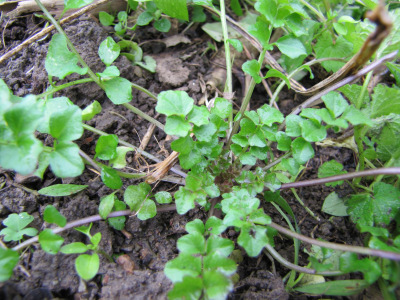 Hairy
Bittercress (Cardamine
hirsuta) always
cheers me up since it's the first flower I see most years, blooming as
early as February or March. Although the bittercress grows its
leaves in a rosette, they are very different from chickweed, never
taking on the sprawling appearance and usually reaching only two or
three inches in diameter. Like the other weeds, Hairy Bittercress
is from Europe and is considered to be edible.
Hairy
Bittercress (Cardamine
hirsuta) always
cheers me up since it's the first flower I see most years, blooming as
early as February or March. Although the bittercress grows its
leaves in a rosette, they are very different from chickweed, never
taking on the sprawling appearance and usually reaching only two or
three inches in diameter. Like the other weeds, Hairy Bittercress
is from Europe and is considered to be edible.
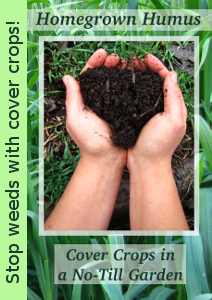 As I read all of the
benefits of our three "worst" winter weeds, I nearly talk myself into
leaving the ground unmulched. But I know that all three of these
guys will quickly go to seed and overrun the garden, a no-no when
running a no-till operation. Next year I hope to mulch earlier
before the seeds germinate.
As I read all of the
benefits of our three "worst" winter weeds, I nearly talk myself into
leaving the ground unmulched. But I know that all three of these
guys will quickly go to seed and overrun the garden, a no-no when
running a no-till operation. Next year I hope to mulch earlier
before the seeds germinate.
Want more in-depth information? Browse through our books.
Or explore more posts by date or by subject.
About us: Anna Hess and Mark Hamilton spent over a decade living self-sufficiently in the mountains of Virginia before moving north to start over from scratch in the foothills of Ohio. They've experimented with permaculture, no-till gardening, trailersteading, home-based microbusinesses and much more, writing about their adventures in both blogs and books.
Want to be notified when new comments are posted on this page? Click on the RSS button after you add a comment to subscribe to the comment feed, or simply check the box beside "email replies to me" while writing your comment.

Thank you so very much for the close ups of the chickweed, etc. We have something called knotweed, I think. I tried giving some to our chickens (who are penned) up and they loved it, then found out it is invasive and am wondering how to rid the yard of it. We have foxes around here which come from the woods, grab a chicken, fling it over the shoulder, and are gone so fast you think you are seeing things, so our girls stay confined. I really feel for them, and keep giving them greens in addition to their feed to keep those yolks orange! They are a mixed collection of brown egg layers with the exception of 6 easter eggers and we are still collecting a dozen or more eggs a day (18 hens total). PS Still awaiting arrival of 5 DIY nipples; maybe today! Clear ice topping the waterers this morning! Happy days!